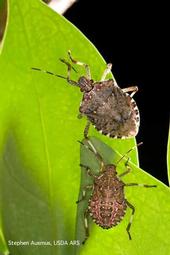
(Credit: S Ausmus)
Stink bugs are common pests in gardens but the brown marmorated stink bug, or BMSB, is of particular concern. BMSB (Halyomorpha halys) was first detected in Los Angeles County in 2006 and has since been detected in many other parts of California with large populations in some counties.
What does BMSB look like?
The adult BMSB is similar in shape to other stink bugs can be distinguished by the following characteristics:
- Two white bands on the antennae
- Forward edge of head is blunt
- Margin of the shoulder is smooth
- Legs are marbled brown with faint white bands
- Membranous parts of...
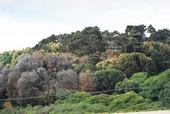
In California, P. ramorum is primarily a leaf pathogen and thrives in coastal tanoak/redwood forests and oak woodlands. There are two categories of hosts for P. ramorum....
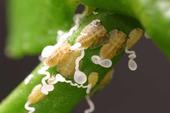
(Credit: ME Rogers)
Invasive species are non-native plants, animals, or pathogens that can cause economic or environmental harm. This year, we will be spotlighting several different invasive species that are established in California to raise awareness and help reduce their spread. Stay tuned—we will be showcasing a different invasive species each day and where you can find more information.
Want to learn more about California Invasive Species Action Week? Check out the full schedule of...
- Author: Karey Windbiel-Rojas
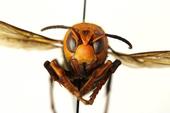
(Credit: Washington State Department of Agriculture)
First things first: "murder" hornets, or more correctly, the Asian giant hornet, have NOT been found in California.
The term murder hornet is also not quite accurate. It attacks honey bees, which isn't desirable of course, but the important thing to note that this insect's purpose is not to murder humans. Right now in California, we are keeping an eye out for this insect so there is no need to worry, yet.
The news and social media have been filled with stories about the Asian giant hornet (AGH) but here are some facts from credible sources:
- Asian giant hornet (Vespa mandarinia) is the world's largest species of hornet, measuring between 1.5 - 2 inches.
- The stinger of AGH is longer than...
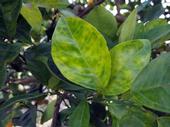
The California Department of Food and Agriculture has declared a quarantine following the detection of Huanglongbing (HLB) in multiple residential citrus trees in Corona (Riverside County). This is the first time HLB has been detected in Corona.
The 107-square mile quarantine area will link up with the east side of the existing quarantine in Los Angeles, Riverside, Orange and San Bernardino counties, creating a contiguous 1,127-square-mile area. The new portion is bordered on the north by Chino Airport, on the south by Black Star Canyon, and on the east by Interstate 15.
The quarantine prohibits the movement of all citrus nursery stock or...


